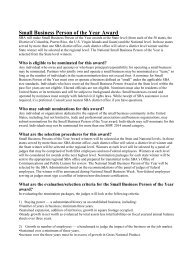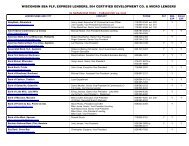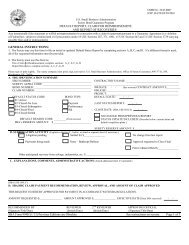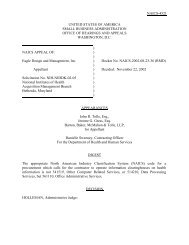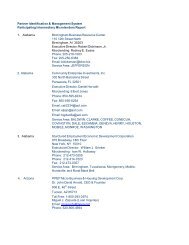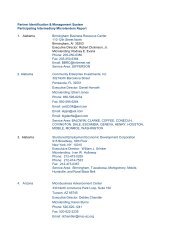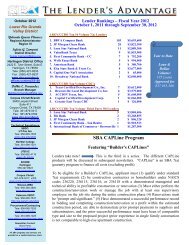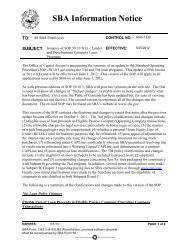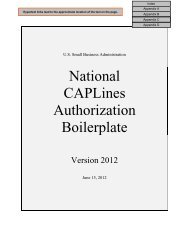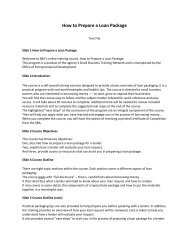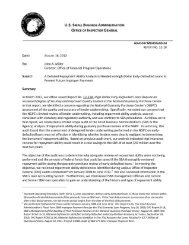Oklahoma Small Business Resource Guide - SBA
Oklahoma Small Business Resource Guide - SBA
Oklahoma Small Business Resource Guide - SBA
You also want an ePaper? Increase the reach of your titles
YUMPU automatically turns print PDFs into web optimized ePapers that Google loves.
CAPITAL<br />
in advance of finalizing an export sale<br />
or contract. With an approved EWCP<br />
loan in place, exporters have greater<br />
flexibility in negotiating export payment<br />
terms — secure in the assurance that<br />
adequate financing will be in place<br />
when the export order is won.<br />
Benefits of the EWCP<br />
• Financing for suppliers, inventory or<br />
production of export goods.<br />
• Export working capital during long<br />
payment cycles.<br />
• Financing for stand-by letters of credit<br />
used as bid or performance bonds or<br />
down payment guarantees.<br />
• Reserves domestic working capital for<br />
the company’s sales within the U.S.<br />
• Permits increased global competitiveness<br />
by allowing the exporter to extend more<br />
liberal sales terms.<br />
• Increases sales prospects in underdeveloped<br />
markets which have high<br />
capital costs for importers.<br />
• Low fees and quick processing times.<br />
Guaranty Coverage<br />
• Maximum loan amount is $5,000,000.<br />
• 90 percent of principal and accrued<br />
interest up to 120 days.<br />
• Low guaranty fee of one-quarter of one<br />
percent of the guaranteed portion for<br />
loans with maturities of 12 months or<br />
less.<br />
• Loan maturities are generally for 12<br />
months or less.<br />
Use of Proceeds<br />
• To pay for the manufacturing costs of<br />
goods for export.<br />
• To purchase goods or services for export.<br />
• To support standby letters of credit to<br />
act as bid or performance bonds.<br />
• To finance foreign accounts receivable.<br />
Interest Rates<br />
The <strong>SBA</strong> does not establish or<br />
subsidize interest rates on loans. The<br />
interest rate can be fixed or variable<br />
and is negotiated between the borrower<br />
and the participating lender.<br />
Advance Rates<br />
• Up to 90 percent on purchase orders.<br />
• Up to 90 percent on documentary letters<br />
of credit.<br />
• Up to 90 percent on foreign accounts<br />
receivable.<br />
• Up to 75 percent on eligible foreign<br />
inventory located within the U.S.<br />
• In all cases, not to exceed the exporter’s<br />
costs.<br />
Collateral Requirements<br />
The export-related inventory and the<br />
receivables generated by the export<br />
sales financed with EWCP funds will<br />
be considered adequate collateral. The<br />
<strong>SBA</strong> requires the personal guarantee<br />
of owners with 20 percent or more<br />
ownership.<br />
22 — <strong>Small</strong> <strong>Business</strong> <strong>Resource</strong> OKLAHOMA<br />
How to apply<br />
Application is made directly to <strong>SBA</strong>participating<br />
lenders. <strong>Business</strong>es are<br />
encouraged to contact <strong>SBA</strong> staff at their<br />
local U.S. Export Assistance Center<br />
(USEAC) to discuss whether they are<br />
eligible for the EWCP and whether it is<br />
the appropriate tool to meet their export<br />
financing needs. Participating lenders<br />
review/approve the application and<br />
submit the request to <strong>SBA</strong> staff at the<br />
local USEAC.<br />
U.S. Export Assistance Center<br />
There are 20 U.S. Export Assistance<br />
Centers located throughout the<br />
U.S. They are staffed by <strong>SBA</strong>, U.S.<br />
Department of Commerce and Export-<br />
Import Bank of the U.S. personnel,<br />
and provide trade promotion and<br />
export-finance assistance in a single<br />
location. The USEACs also work closely<br />
with other federal, state and local<br />
international trade organizations to<br />
provide assistance to small businesses.<br />
To find your nearest USEAC, visit:<br />
www.sba.gov/content/us-export-assistancecenters.<br />
You can find additional export<br />
training and counseling opportunities<br />
by contacting your local <strong>SBA</strong> office.<br />
U.S. Export Assistance Center Location<br />
(USEAC)<br />
John Blum, Regional Manager<br />
Office of International Trade<br />
Export Solutions Group<br />
8235 Forsyth Blvd., Ste. 520<br />
St. Louis, MO 63105<br />
314-425-3304 • 314-425-3381 Fax<br />
john.blum@trade.gov<br />
CERTIFIED DEVELOPMENT<br />
COMPANY LOAN PROGRAM<br />
(504 LOANS)<br />
The 504 Loan program is an economic<br />
development program that supports<br />
American small business growth and<br />
helps communities through business<br />
expansion and job creation. This <strong>SBA</strong><br />
program provides long-term, fixedrate,<br />
subordinate mortgage financing<br />
for acquisition and/or renovation of<br />
capital assets including land, buildings<br />
and equipment. Some refinancing is<br />
also permitted. Most for-profit small<br />
businesses are eligible for this program.<br />
The types of businesses excluded from<br />
7(a) loans (listed previously) are also<br />
excluded from the 504 loan program.<br />
Loans are provided through Certified<br />
Development Companies. CDCs work<br />
with banks and other lenders to make<br />
loans in first position on reasonable<br />
terms, helping lenders retain growing<br />
customers and provide Community<br />
Redevelopment Act credit.<br />
The <strong>SBA</strong> 504 loan is distinguished<br />
from the <strong>SBA</strong> 7(a) loan program in<br />
these ways:<br />
The maximum debenture, or long-term<br />
loan, is:<br />
• $5 million for businesses that create a<br />
certain number of jobs or improve the<br />
local economy;<br />
• $5 million for businesses that meet a<br />
specific public policy goal, including<br />
veterans; and<br />
• $5.5 million for manufacturers and<br />
energy public policy projects.<br />
Recent additions to the program<br />
allow $5.5 million for each project<br />
that reduces the borrower’s energy<br />
consumption by at least 10 percent;<br />
and $5.5 million for each project that<br />
generates renewable energy fuels, such<br />
as biodiesel or ethanol production.<br />
Projects eligible for up to $5.5 million<br />
under one of these two requirements<br />
do not have to meet the job creation<br />
or retention requirement, so long as<br />
the CDC portfolio average is at least<br />
$65,000.<br />
• Eligible project costs are limited<br />
to long-term, fixed assets such as<br />
land and building (occupied by the<br />
borrower) and substantial machinery<br />
and equipment. Working capital is not<br />
an eligible use of proceeds, except in a<br />
temporary program which is scheduled<br />
to expire on September 27, 2012.<br />
• Most borrowers are required to make<br />
an injection (borrower contribution)<br />
of just 10 percent which allows<br />
the business to conserve valuable<br />
operating capital. A further injection<br />
of 5 percent is needed if the business<br />
is a start-up or new (less than 2<br />
years old), and a further injection of 5<br />
percent is also required if the primary<br />
collateral will be a single purpose<br />
building (such as a hotel).<br />
• Two-tiered project financing: A lender<br />
finances approximately 50 percent of<br />
the project cost and receives a first<br />
lien on the project assets (but no <strong>SBA</strong><br />
guaranty); A CDC (backed by a 100<br />
percent <strong>SBA</strong>-guaranteed debenture)<br />
finances up to 40 percent of the project<br />
costs secured with a junior lien. The<br />
borrower provides the balance of the<br />
project costs.<br />
• Fixed interest rate on <strong>SBA</strong> loan. <strong>SBA</strong><br />
guarantees the debenture 100 percent.<br />
Debentures are sold in pools monthly<br />
to private investors. This low, fixed<br />
rate is then passed on to the borrower<br />
and establishes the basis for the loan<br />
rate.<br />
• All project-related costs can be<br />
financed, including acquisition (land<br />
and building, land and construction of<br />
building, renovations, machinery and<br />
equipment) and soft costs, such as title<br />
insurance and appraisals. Some closing<br />
costs may be financed.<br />
• Collateral is typically a subordinate<br />
lien on the assets financed; allows<br />
Visit us online: www.sba.gov/ok




